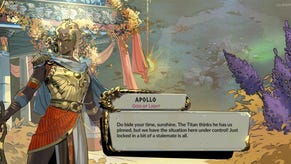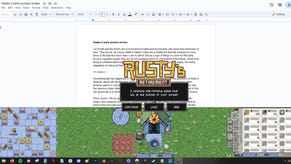The RPS 2016 Advent Calendar - Dec 1st: INSIDE
Step through the door
What is the best dystopia of 2016, the official year of the dystopia? The RPS Advent Calendar highlights our favourite games of the year, daily, and behind today's door is...
Alec: I like it even more in hindsight than I did at the time, now that the sting of its handful of less successful puzzles has faded and I’m left with the broader memory of the journey as a whole.
My mind returns to Inside surprisingly often. Its freaky sights, its malevolent puzzles, its tar-black comedy, the elegance of its forward motion, the perfect sickness of the ending. It all comes together beautifully.
Apart from the friendly chicks puzzle. I still don’t get the thinking behind the friendly chicks puzzle. No - no, let it go, Meer.
Every time my mind returns to Inside, I want to replay it, then swiftly realise that no, I do not want to repeat the experience. Its black magic would be lost if I knew what was up ahead, was denied the laughter and the horror of what it might spring on me next. Inside’s a ghost train in a way. I’d never want to ride the same ghost train again, but I would want to ride another one, with the same essential system but different surprises.
I love the completeness of Inside. From its seemingly real-world, sinister beginning, through a series of awful, wonderful places and sci-horror themes that imply but fortunately do not over-explain their interconnectedness. The escalation, from simple chase to nightmare pigs to weird science to dreams of drowning to apocalypse to bio-shock destruction derby, is sublime. And that ending. Ideal. Bleak, funny, final.
Inside flows, too. It flows so well. I can barely understand how it achieves it - it’s fundamentally a game about trial and error, which historically I have little patience for.
To play Inside is to be killed suddenly and often horribly without warning. In so many other games that do this, I feel my time has been wasted. In Inside, it is the death that reveals the solution. I can push straight on, with new knowledge, flowing forwards anew. This is such a tight, slick game, with its own weirdo internal logic.
Apart from the friendly chicks. I don’t get the friendly chicks.
Adam: I didn’t like Limbo. My memories of it are of pre-release images, perhaps even a gif, that made me extremely excited about creeping through Another gloomy World. That was always the reference point I was interested in - Another World - but the game turned out a little more like Rick Dangerous, and Rick Dangerous is my least favourite game of all time.
There are brilliant moments in Limbo, mostly focused around that awful spider and its even more awful ending, but it fell too much into the “walk forward and then die” school of game design for me to tolerate it for long.
Inside is nowhere near as happy to kill you. Yes, the kid you play comes to a sticky end over and over again, but there are whole stretches of the game where you’re just enjoying the background detail and piecing together the workings of the world in your mind, and there isn’t a single dog tearing your throat out and none of the men are trying to smother you.
Exploring Inside, which mostly involves going from left to right and occasionally stopping to solve an environmental puzzle or do a bit of swimming, is delightful. It’s dark and moody and dystopian, but there’s a lightness of touch in the animations and, as Alec argued earlier this year, later developments are so grotesquely absurd as to be equal parts horror, tragedy and black comedy.
I found it creepy, strange, disconcerting and shocking. John’s reaction to the final act was one of disappointed surprise, and I was surprised too - but my “I can’t believe they’ve done that” was followed by a short round of applause.
Inside does insert some big ideas into its slender and sinister frame, but that’s not why I loved it - it’s the execution of the big, broad, b-movie elements that I adored, and that the whole thing is short enough to complete in a single setting meant it never lost momentum when I played it the first time. I’ve already played it a second time because it’s the kind of game that is fun to enjoy in company. I’d like to incorporate it into a Halloween playlist next year, in between a couple of films.
Pip: HELLO. I wanted to pop in and remind people about how Inside has lovely animation, particularly when it comes to small-scale movements. I spent an inordinate amount of time just making the boy run to and fro so I could repeat little animation cycles. There's a really good understanding of how to change posture and speed of movements to imply particular types of mood and behaviour.
John: Awfully sorry to bother you, but Inside was really poor. Pip’s right that the animations were incredible, but the game was badly strung together, woefully misunderstood what made Limbo clever (suggesting they didn’t get their own game), genuinely vile at times, and just so achingly dumb with the stupidest ending to any game ever. Alec has to deludedly imagine that it was aiming for comedy to like it (but not enough to want to play it ever again…), Adam seems to justify its utterly erratic inconsistency of mood as a skill, despite being yet another of its enormous failings. Making me think that there’s some sort of hypnosis spell in the game to which I am for some reason invulnerable. “The game is bad for all these reasons, so therefore it’s really good!” No. No. It’s just bad. It’s a bad game.
Adam: You can tell that John is wrong because he thinks Limbo is clever.












